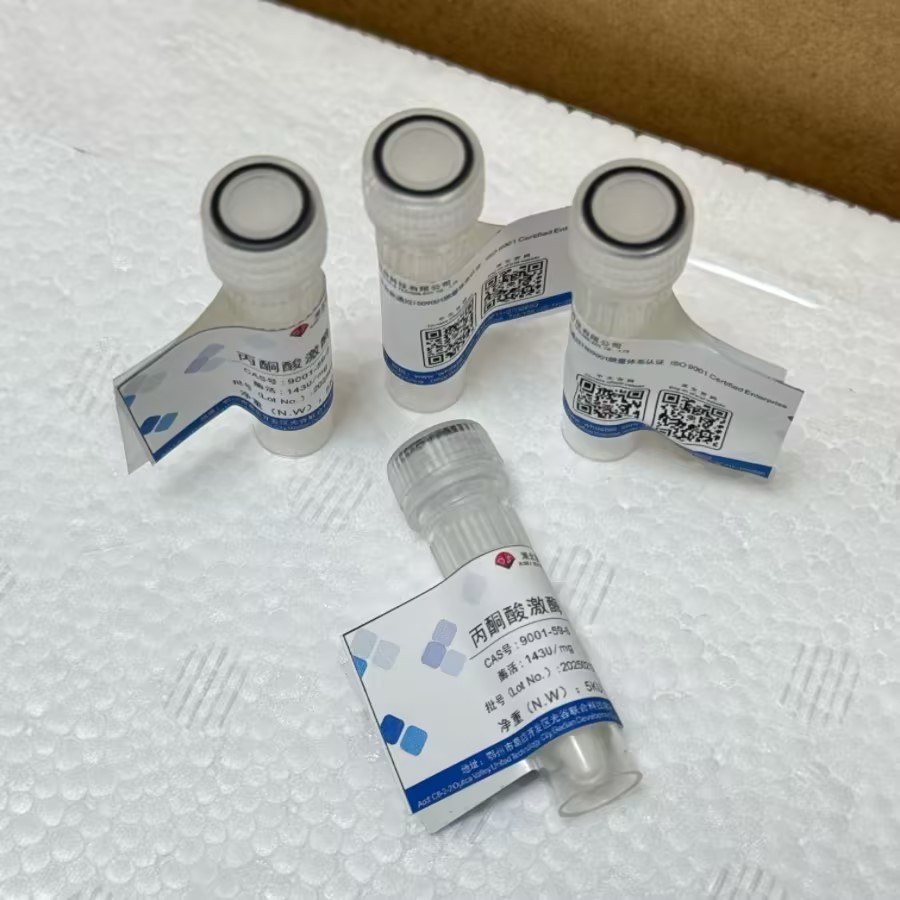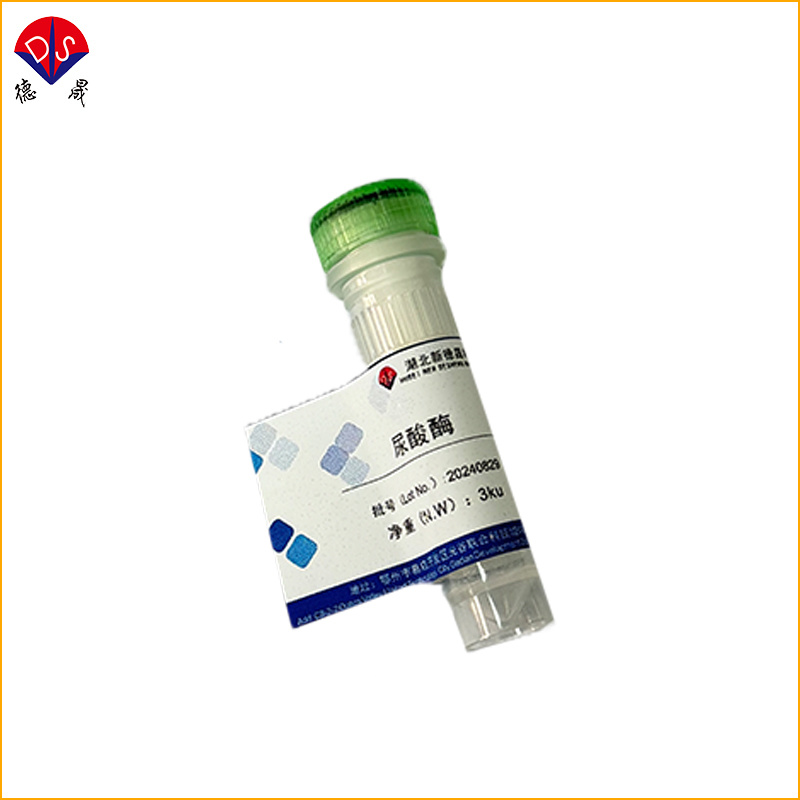Classification of IVD Reagent Raw Materials Enzymes and Coenzymes
Release time:
2025-04-17
In the vast system of in vitro diagnostic reagent materials, enzymes and coenzymes play an extremely important role and are key elements in promoting the smooth progress of various diagnostic reactions. The classification of enzymes and coenzymes in IVD reagent raw materials is complex and precise, and different types of enzymes and coenzymes play their roles in their respective fields.

Pyruvate kinase
1、 Enzymes and Coenzymes in the IVD Reagent Raw Material Market Pattern
The IVD reagent raw material market is rich and diverse, generally divided into four categories according to market size, including antigen antibodies, enzymes/coenzymes/substrates, magnetic beads/microspheres/NC membranes, probe primers, and chemical raw materials. In 2022, the domestic IVD raw material market will be in the range of 13-14 billion yuan. Among them, antigen and antibody as major raw materials account for about 40-45%, with a scale of approximately 5.5 billion yuan; And enzymes/coenzymes/substrates closely follow, ranking in the second category, accounting for about 25-28%, with a scale of approximately 3.5 billion yuan. This clearly demonstrates the important position of enzymes and coenzymes in the IVD reagent raw material market. They are not only important cornerstones for building IVD reagents, but also key forces driving industry development.
2、 The essence and function of enzymes
Enzymes, as biochemical catalysts, are essentially proteins or RNA. In the complex system of IVD reagent raw materials, enzymes mainly exert their skills in the core reaction system and signal system of the reagent. In the core reaction system, enzymes can reduce the activation energy of chemical reactions, accelerate the progress of diagnostic reactions, and make detection faster and more accurate. When detecting a certain biomarker, enzymes can catalyze related chemical reactions, promoting specific binding between the biomarker and other components in the reagent, thereby achieving accurate detection of the biomarker. In the signal system, enzymes catalyze substrates to produce detectable signals, such as color changes, fluorescence emissions, etc., providing intuitive basis for the interpretation of detection results.
3、 Classification of enzymes based on their reaction properties
Oxidoreductases: These enzymes can catalyze substrate redox reactions and are commonly used in IVD reagents to detect substances with redox activity. In blood glucose detection reagents, glucose oxidase can oxidize glucose to gluconic acid and produce hydrogen peroxide. Subsequently, the concentration of blood glucose can be indirectly measured by detecting the content of hydrogen peroxide.
Transferase: Transferases can catalyze the transfer reaction of functional groups between substrates. In liver function testing reagents, alanine aminotransferase can transfer the amino group of alanine to alpha ketoglutarate, generating pyruvate and glutamate. The rate of this reaction can be measured to evaluate liver function.
Hydrolases: Hydrolases can catalyze the hydrolysis reaction of substrates. In lipase detection reagents, lipase can hydrolyze fat into fatty acids and glycerol. The activity of lipase can be determined by detecting the amount of fatty acid production, which can assist in diagnosis.
Lysase: Lysase can cleave substrate molecules into two or more smaller molecules. In the detection of certain cancer biomarkers, lyases can cleave large molecule cancer biomarkers into small molecule fragments with specific structures, facilitating subsequent detection and analysis.
Isomerase: Isomerase catalyzes the isomerization reaction of substrate molecules. In carbohydrate metabolism related detection reagents, isomerases can convert one carbohydrate isomer into another to meet detection requirements.
Synthase: Synthase can catalyze the synthesis of a larger molecule from two molecules while consuming energy. In molecular diagnostic reagents related to DNA synthesis, DNA polymerase, as a synthetic enzyme, can connect nucleotides into new DNA strands according to the sequence of the template strand.
Translocation enzyme: Translocation enzyme catalyzes the transfer of functional groups within substrate molecules. In some complex biochemical reaction detection, translocated enzymes play a role in adjusting molecular structure.
Enzyme substrate: Enzyme substrate is the object of enzyme action, which undergoes a chemical reaction after specific binding with the enzyme. In the colorimetric substrate detection system, enzyme substrates react under the catalysis of enzymes to produce color changes, thereby achieving the detection of enzyme activity or related substances.
Coenzyme: Coenzyme is a type of organic small molecule that can transfer chemical groups from one enzyme to another, and can only exert catalytic activity after binding with the enzyme to form a whole enzyme. In many oxidoreductase reactions, the coenzyme NAD+(nicotinamide adenine dinucleotide) can accept or provide electrons to assist the enzyme in completing the catalytic process.

uricase
4、 Classify enzymes by application field
Biochemical diagnostic enzymes: Biochemical diagnostic enzymes are widely used in the detection of various biochemical indicators, such as blood glucose, blood lipids, liver function, kidney function, etc. In blood lipid detection, multiple enzymes such as cholesterol oxidase and glycerol kinase work together.
Molecular diagnostic enzymes: Molecular diagnostic enzymes play a core role in the field of molecular diagnosis, such as Taq DNA polymerase, which is indispensable in PCR (polymerase chain reaction) technology. It can amplify DNA fragments in vitro and detect pathogen nucleic acids, gene mutations, etc.
Immunodiagnostic enzymes: Immunodiagnostic enzymes are commonly used in immunoassay reagents to catalyze substrates to generate signals, enabling the detection of antigens or antibodies.
Coagulation diagnostic enzyme: Thrombin can convert fibrinogen into fibrin, promoting blood clotting. In the four coagulation tests, the coagulation function of the human body is evaluated by measuring indicators such as prothrombin time and activated partial thromboplastin time.
As a manufacturer of enzyme raw materials, Hubei Xindesheng can supply a wide variety of enzyme raw materials. In the production of in vitro diagnostic reagents, we assist in the accurate detection of biochemical indicators such as blood glucose and blood lipids, and have established cooperative relationships with multiple enterprises. If you have any purchasing needs, please feel free to contact us at any time!
News
Contact details
Contact number
Address: C8, Guanggu United Science and Technology City, Ezhou City, Hubei Province
Fax:0711-3704 589
Follow us



